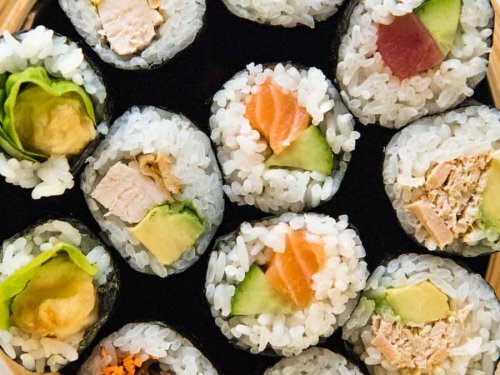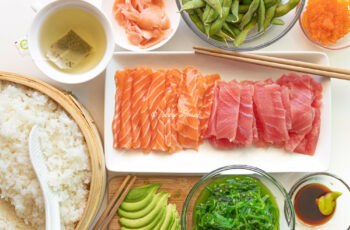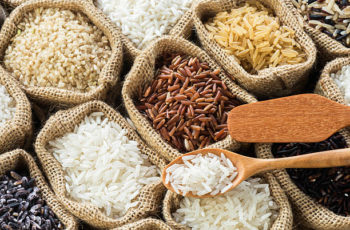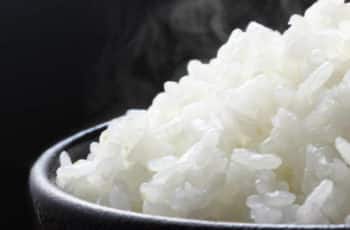Table of contents
Sushi rice ingredients and their role in creating the perfect sushi texture
I. Introduction
Sushi is a popular Japanese dish enjoyed by people all over the world. One of the essential components of sushi is the sushi rice, also known as shari. It is the foundation of the sushi roll, and its texture and flavor play a crucial role in the overall taste of the dish.
Sushi rice is distinct from regular rice as it is seasoned with vinegar, sugar, and salt, which gives it a slightly tangy flavor and sticky texture. It is cooked in a specific way to ensure that the grains are tender and do not break apart when rolled into sushi.
In this article, we will explore the essential ingredients for making perfect sushi rice, their role in creating the right texture and taste, and some tips for achieving the best results when making sushi rice.

Sushi rice ingredients and their role in creating the perfect sushi texture
II. Essential Ingredients for Sushi Rice
- Short-grain rice: Short-grain rice is the preferred type of rice for sushi making as it is sticky and can be easily molded into various shapes. It has a high starch content, which is responsible for the stickiness of sushi rice. There are different varieties of short-grain rice available, and some of the most popular ones for sushi making are Koshihikari, Sasanishiki, and Calrose.
- Water: The quality of the water used to cook sushi rice is crucial as it affects the taste and texture of the rice. It is recommended to use filtered water to remove any impurities that might affect the rice’s taste. The water quantity and temperature are also crucial in cooking the rice correctly. The rice to water ratio should be 1:1.1, and the water temperature should be around 40-50°C.
- Rice vinegar: Rice vinegar is the essential ingredient that gives sushi rice its distinct flavor. It is made from fermented rice and has a mild, slightly sweet taste. The vinegar helps to break down the starch in the rice, making it easier to digest and giving it the sticky texture that sushi rice is known for. If you do not have rice vinegar, you can use white wine vinegar or apple cider vinegar as a substitute.
- Sugar: Sugar is an essential ingredient in sushi rice as it provides sweetness and helps to balance the acidity of the rice vinegar. It also helps to enhance the rice’s flavor and texture. The recommended amount of sugar to use is around 1 tablespoon per cup of uncooked rice.
- Salt: Salt is added to sushi rice to enhance its flavor and to act as a preservative. It also helps to prevent the rice from spoiling and prolongs its shelf life. The recommended amount of salt to use is around 1 teaspoon per cup of uncooked rice.
III. Sushi Rice Seasoning
Sushi rice seasoning is a crucial step in achieving the perfect texture and flavor of sushi rice. It is a combination of rice vinegar, sugar, and salt, which is mixed and heated before adding it to the cooked rice. Here is a simple recipe for sushi rice seasoning:
Ingredients:
- 1/2 cup of rice vinegar
- 1 tablespoon of sugar
- 1 teaspoon of salt
Instructions:
- In a small saucepan, combine the rice vinegar, sugar, and salt.
- Heat the mixture over medium heat, stirring occasionally, until the sugar and salt dissolve.
- Remove the mixture from heat and let it cool to room temperature before using it to season the cooked rice.
Proper seasoning is crucial in achieving the perfect texture and taste of sushi rice. The right balance of sweet, sour, and salty flavors is necessary to complement the fillings and toppings used in sushi rolls. A well-seasoned sushi rice should be slightly sweet and tangy, but not overpowering.
If you do not have traditional Japanese ingredients such as mirin or sake, you can use alternatives like white wine, apple juice, or sugar syrup to achieve a similar flavor profile. However, it is important to note that these substitutions may alter the taste of the sushi rice slightly.
IV. Tips for Making Perfect Sushi Rice
- Techniques for rinsing and cooking rice: Rinsing the rice thoroughly before cooking removes excess starch and debris, which can affect the texture of the rice. It is recommended to rinse the rice several times until the water runs clear before cooking. Cooking the rice over low heat and letting it simmer for around 20-25 minutes ensures that the rice is cooked evenly and to the right consistency.
- Importance of cooling and mixing rice with seasoning: After cooking the rice, it is essential to let it cool before seasoning it. This allows the rice to absorb the seasoning evenly and prevents it from becoming mushy. Mixing the rice gently with the seasoning using a wooden spoon or spatula is important to prevent the rice from becoming sticky and clumping together.
- Common mistakes to avoid when making sushi rice: One of the most common mistakes when making sushi rice is using too much water or not enough water, which can affect the texture and taste of the rice. It is important to measure the water carefully and use the right ratio of water to rice. Another mistake is overcooking or undercooking the rice, which can make it either mushy or hard.
V. Sushi Rice Variations and Alternatives
While traditional sushi rice is made with short-grain rice, rice vinegar, sugar, and salt, there are variations and alternatives that you can try. For example, you can make sushi rice without vinegar by using lemon juice or apple cider vinegar instead. You can also make sushi rice without sugar by substituting it with honey or agave syrup, and without Japanese ingredients like mirin or sake by using white wine or rice wine vinegar.
Additionally, you can experiment with alternative ingredients like quinoa, brown rice, or cauliflower rice to make sushi rolls. These options provide a healthier and gluten-free alternative to traditional sushi rice. However, it’s important to note that using these alternatives may alter the taste and texture of the sushi rolls. While quinoa and brown rice can be cooked in a similar way to sushi rice, cauliflower rice requires a different cooking method to ensure it is not too moist.
When using non-traditional ingredients in sushi rice, it’s essential to consider the pros and cons. On one hand, using alternative ingredients can offer a healthier and unique twist to sushi rolls. On the other hand, non-traditional ingredients may not provide the right texture and flavor that is expected from sushi rice.
VI. Conclusion
In conclusion, sushi rice is an essential ingredient in making delicious sushi rolls. The combination of rice vinegar, sugar, and salt creates the perfect balance of flavors that complements the fillings and toppings used in sushi rolls. Proper technique and attention to detail are crucial in achieving the perfect texture and taste of sushi rice.
While there are variations and alternatives to traditional sushi rice, it’s important to consider the potential alterations to taste and texture when using non-traditional ingredients. Experimenting with alternative ingredients can offer a healthier and unique twist to sushi rolls, but the traditional recipe provides the classic taste and texture of sushi rice.
Overall, making perfect sushi rice at home requires practice and patience. Following the tips and techniques mentioned in this article can help you achieve the perfect texture and taste of sushi rice. So, get creative, experiment with different ingredients and enjoy making sushi rolls at home!








